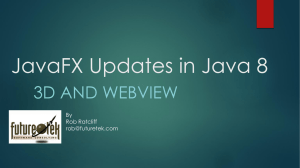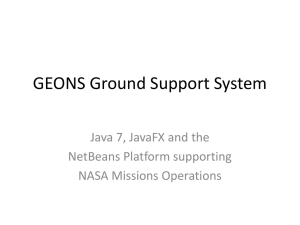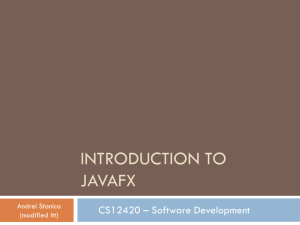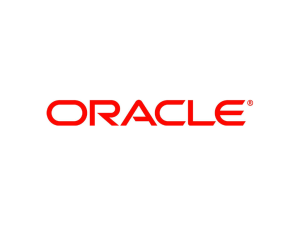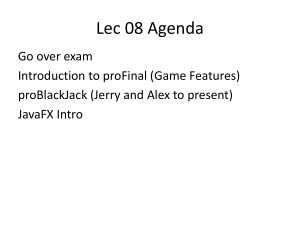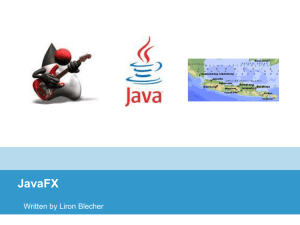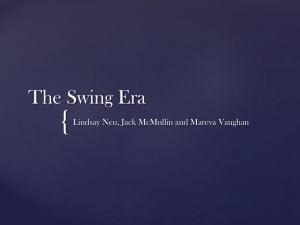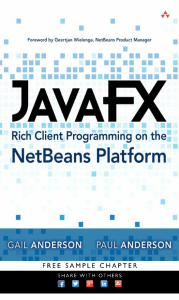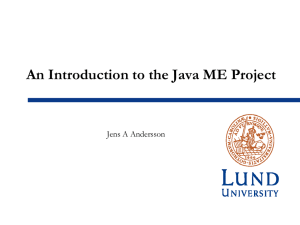con3530
advertisement
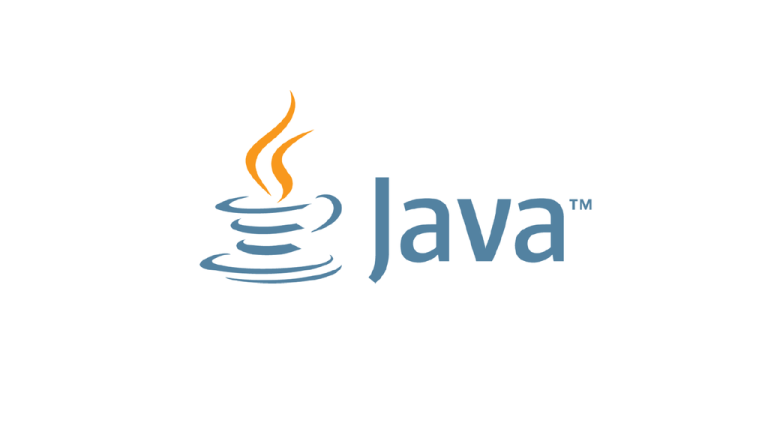
1
Practical Pros & Cons
of Replacing Swing with
JavaFX in Existing
Applications
2
JavaFX provides a rich client API as a new and exciting way
to develop client user interfaces. What are its key strengths
and weaknesses? Is it ready to be used in production to
replace Swing?
This panel discussion addresses the relevance of JavaFX in
the context of existing Swing applications. It demonstrates
and analyzes applications created in farm management,
logistics, mission operations, and artificial intelligence.
The panelists show how their applications based on the
NetBeans application framework leverage JavaFX, and they
share their experiences of replacing Swing with JavaFX and
porting Swing components to JavaFX.
3
Fair Questions to Ask
Readiness
– Is JavaFX ready to be used, at all?
– What does “ready” mean? “Ready for toy applications” is not “Ready”, for example.
– If JavaFX is ready, what are the risks for using it? Can its readiness be reverted?
– How to mitigate the risks, how to keep all options open, how to adopt carefully.
Relevance
– If it is ready and risks can be mitigated, what is its place in existing Swing applications?
– Does it have a place, at all?
– What are the actually useful features that JavaFX provides, versus all the hype and buzz, etc?
Replacement
– Which parts of JavaFX to use and the strategies for doing so
– Replace all of Swing with JavaFX? Swap out Swing during upgrades?
– Don’t reinvent the wheel if others have walked the road already
4
Sean Phillips
Timon Veenstra
Rob Terpilowski
Commonalities:
– Large applications, heavy investment
– Based on NetBeans Platform application framework
– Tomorrow 16:30 - 17:30: CON4171
Hitchhiker’s Guide to the NetBeans Platform
(Hilton - Continental Ballroom 6)
5
GEONS Ground Support System
Java 7, JavaFX and the
NetBeans Platform supporting
NASA Missions Operations
6
Java for NASA Mission Support
The GEONS Ground Support System (GGSS) is an independent software
tool designed to support analysis and mission operations using NASA
GEONS.
The GGSS uses the NetBeans Platform as the basis of the ground system
software and will support a 2014 launch of the Magnetospheric Multiscale
mission (MMS).
The GGSS is currently deployed in the MMS Mission Operations Control
room at the Goddard Space Flight Center (GSFC) now for iterative
acceptance testing.
The NetBeans Platform and the latest version of Java 7 has met all the base
Mission Requirements for the GGSS.
JavaFX support for charting has been added to the original design as a
means of rapid data exploration by both operators and analysts.
7
MMS Mission Overview
Earth
Solar
Wind
Sample regions of Scientific Interest at
Dayside Magnetopause and the Nightside
Neutral Sheet
for a 24 month mission lifetime.
8
Mission Planning Complexity
• 12 Planned Apogee raising burns
• Tetrahedron Formation
• Close Approach avoidance
Maneuvers
occur in partial
shadow
Orbits trace shown in Inertial Frame
9
Orbit in the Life
Region of Interest
Maneuver #2
Orbit Only
Real-time
GEONS
Telemetry
GPS Rx OFF
Maneuver #2
Perigee Raise Only
Apogee
Perigee
DSN Dumps
Of GEONS
Telemetry
Desired
Tetrahedron
Maneuver #1
Orb/Att/Spin
10
50 hr GPS outage
Data Product Generation using
NetBeans Platform
• NetBeans Platform naturally well suited to fundamental need of all ground
system software which is data product generation and management.
• Plugin architecture makes integrating core GEONS-related functions easy
• Platform is “easily” extendable for other missions flying GEONS
• GGSS should be able to be ported outside of the FDOA (e.g. to the FDF)
for support on other missions with minimum impact (e.g. platform
independent with clean interfaces to integrate with external packages
such as propagators, telemetry extraction, and product formatting utilities)
• Routine operations can be automated (e.g. initiated via command line or
script)
• Highly desirable that GGSS not require costly non-portable licenses
11
Quick Data Exploration using JavaFX
JavaFX charting capabilities have enhanced the original design of the
GGSS.
The GGSS can now provide easy and rapid chart views of different data
vectors an a large variety of combinations.
JavaFX facilitated this by reducing the development time (and therefore
cost) of the following points:
• Easy Drag-And-Drop Event Handling
• Easy Custom Serialized DataFormat and Clipboard support
• Simplified Concurrency for GUI Rendering
The Combination of the NetBeans Platform custom File Type and the Swing
Interop pattern made adding this JavaFX charting view straight forward.
12
Pros vs Cons on Adding JavaFX to Swing
Applications
Should you add JavaFX to your Java GUI???
Pros
Cons
•
Highly reactive GUI components are
simpler to develop
•
Bidirectional Event monitoring between Swing
and JavaFX is still a pain.
•
Reduced development time for rich GUI
components
•
JavaFX and Heavyweight controls still do not
play nice.
•
Reduced code footprint for new
components reduces maintenance costs
•
Making JavaFX components reusable for Swing
and pure JavaFX not so easy
•
Most of what JavaFX offers is viable via
combination of Swing and 3rd party libraries.
13
Suggestions for JavaFX Adoption
As a "Swing guy" I have really come to appreciate how easy Drag/Drop,
Animation and GUI event handling in general is now in JavaFX.
Implementing the interactive Drag and Drop chart controls was FUN!
However JavaFX upgrades to Java are mostly extra nice to haves. To
really sell the next generation of developers and convince the current
generation to switch how about the following:
• More and better 3D rendering support
• Fix and Improve support for Heavyweight components for
improved backward compatibility
• Keep driving toward features that produce a measurable reduction
in development time. You can’t argue with the bottom line!
14
Appendix of Links
Goddard Space Flight Center Portal
http://www.nasa.gov/centers/goddard/home/index.html#.Ufh0KW2f2H
M
GEONS Technical Site
http://techtransfer.gsfc.nasa.gov/ft_tech_geons.shtm
MMS Mission Site
http://mms.gsfc.nasa.gov/
ai Solutions, Inc
http://www.ai-solutions.com/
15
16
17
18
Freight Management with
JavaFX on the NetBeans Rich
Client Platform
Rob
Terpilowski
Lynden, Inc.
19
About Me
•
Application Architect at Lynden, Inc.
•
Technical lead for our freight planning and management application,
“FMS”.
20
Operating Companies
21
The Problem
Where’s my freight???
22
Freight Management RCP App with Swing
23
Extreme Makeovers
24
25
26
JavaFX UI Design with Scene Builder
27
public FXPlanningTopComponent() {
Adding JavaFX to the Swing UI
initComponents();
setName(Bundle.CTL_FXPlanningTopComponentTopComponent());
setToolTipText(Bundle.HINT_FXPlanningTopComponentTopComponent());
Platform.setImplicitExit(false);
Platform.runLater(new Runnable() {
public void run() {
Parent root;
try {
root = FXMLLoader.load(
getClass().getResource("/com/lynden/planning/ui/InboundPlanning.fxml"));
JFXPanel jfxPanel = new JFXPanel();
jfxPanel.setScene(new Scene(root));
} catch (IOException ex) {
Exceptions.printStackTrace(ex);
}
}
});
setLayout(new BorderLayout());
add(jfxPanel, BorderLayout.CENTER);
}
28
JavaFX in a NetBeans RCP App
29
Contact Info
Rob Terpilowski
Email: robt@Lynden.com
Twitter: @RobTerp
Blog: http://rterp.wordpress.com
30
Questions?
31
Sean Phillips
–
sean.mi.phillips@gmail.com
–
@SeanMiPhillips
Timon Veenstra
–
timon@agrosense.eu
–
@TimonVeenstra
Rob Terpilowski
–
robt@Lynden.com
–
@RobTerp
Geertjan Wielenga
–
geertjan.wielenga@oracle.com
–
@geertjanw
Commonalities:
Tomorrow 16:30 - 17:30:
CON4171 Hitchhiker’s Guide to the NetBeans Platform
(Hilton - Continental Ballroom 6)
32
33
